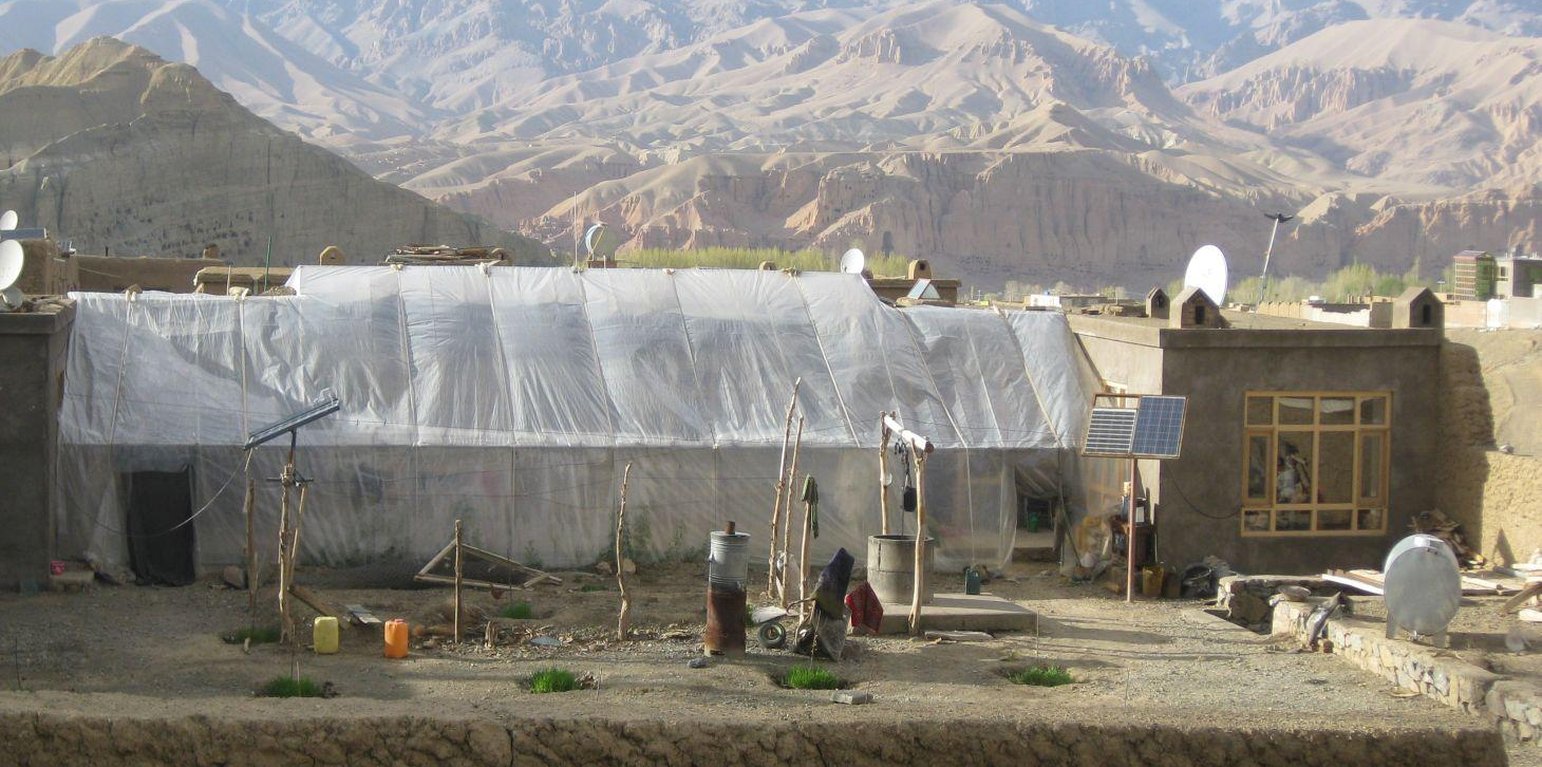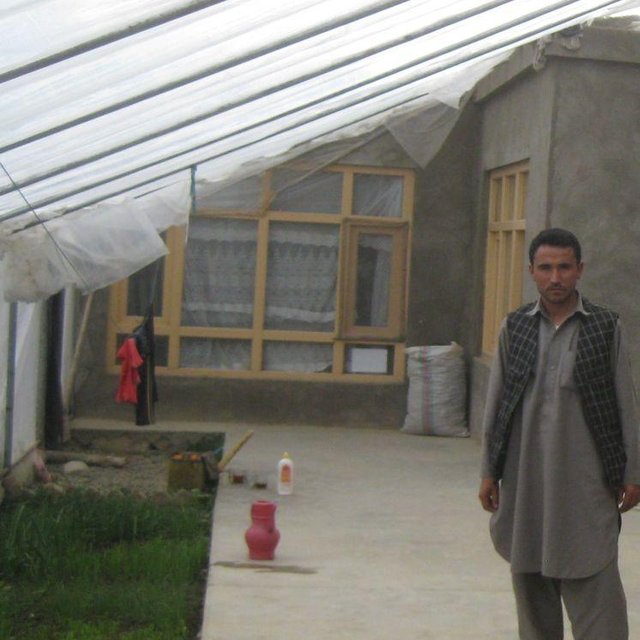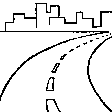



Passive Solar House technology is documented by Sustainable Land Management Project/HELVETAS Swiss Intercooperation with financial support of Swiss Agency for Development and Cooperation.
Households in Bayman Centre experience very cold winters and meeting household energy needs for the Bamyan population is challenging. They mostly rely on unsustainable solutions such as burning manure or mountain shrubs. Shrub harvesting for firewood is a major cause of land degradation in the province. Fuel expenses also deplete the financial resources of an already impoverished population. Also, due to the intense cold, very few activities are possible during the winter. To overcome the challenges of heavy dependence on biomass for winter heating and to improve living conditions, many families in Bamyan Centre are adopting the passive solar technology for improving their living conditions, while reducing pressure on environment.
Passive solar technology captures sunlight in a room or building, and converts that energy into low-temperate heat. It provides an efficient mean of capturing the sun's energy, reducing the need for fuel wood and coal for heating.
(1)The passive solar house (PSH) technology has significant economic, socio-cultural and environmental benefits. They are as follows:
(2)reducing the reliance on shrubs and other heating materials; saving expenditure on fuel (aprox.25,000 Afghani/year) and the time usually spent on harvesting bushes;
(3)provision of extra space in the house for washing/drying cloths, bathing, social activities, play and study area, space for vegetable crops for home consumption; savings due to this technology offset the high initial investment cost;
(4)improved health due to less exposure to cold;
(5)reduced pressure on environment. The technology contributes to re-greening of common lands or rangelands where fewer shrubs are collected (uprooted) for firewood.
PSH should have a Southern exposure to take maximum advantage of the sun for daylight and passive solar heating. Most of the houses in Bamyan have southern exposures. The PSH is generally used for 6 months (November to April).
Although the technology was introduced in Bamyan by GERES, an International Non-Governmental Organization, many families have replicated it without any external support.
The main purpose of Passive Solar House technology is to make use of the solar energy for heating homes. As a result, the need for shrubs and coal for home heating is reduced significantly. The technology contributes to re-greening of common lands or range lands on which shrubs are harvested (uprooted) for firewood. Barat Ali's family bought about 60 donkey loads of shrubs per year for winter heating purposes. They did not have to do that after this technology was implemented by the PSH owner. The technology also contributes to the well-being of all family members, especially of women, who can do their household chores, and children who often got sick due to cold exposure.
The PSH presented here was established in September 2013 before the onset of winter. A transparent plastic sheet, metal pipes, wires and ropes to hold the plastic are used for construction work. Metal pipes were purchased from Kabul by the owner.
The PSH measures 17 m in length, 5 m in width and about 4 m in height. However, the PSH may vary from one house to another. The factor to consider is that the PSH should have long area to capture maximum sunlight. The upper part is slopping (about 30% gradient) to drain the water and snow. Local semi-skilled labor and skilled mechanic for welding the pipes were employed for construction works.
Approximately 45,000 Afghani/790 USD was spent on the construction of this PSH. The owner made significant investment. He purchased the pipes and plastic contributing approximately 70% of the costs. Plastic sheets, which are available on the market in Bamyan, are not of very high quality and have to be replaced each year. If the used plastic sheet is not too damaged, it is placed on roofs to protect from snow water/rain seepage. Otherwise, it is simply thrown away, which is not an environment friendly practice.
According to the PSH owner, a possibility for improvement is to use good quality wooden frame instead of pipes so that the plastic sheet can be kept intact by nailing it to the wooden frame. Using wooden frames may also reduce the cost of the technology, making it more affordable for poor families. Provision for ventilation is an aspect which needs to be considered while constructing PSH.
Bamyan province is a remote province of Afghanistan with high poverty rate. It has a temperate and arid climate. During winter, temperatures can drop below minus 22 degrees. Summer temperature can reach up to 34 degrees in the month of July. The average annual rainfall in the area is about 230 mm and some years can be very dry.
90% of the population relies on subsistence agriculture for their livelihoods and off-farm activities are marginal.
สถานที่: Bamyan Center / Dashte Esakhan, Bamyan, อัฟกานิสถาน
ตำนวนการวิเคราะห์เทคโนโลยี:
การเผยแพร่ของเทคโนโลยี: กระจายไปอย่างสม่ำเสมอในพื้นที่ (0.00027 km²)
In a permanently protected area?:
วันที่ในการดำเนินการ: น้อยกว่า 10 ปี (ไม่นานนี้)
ประเภทของการแนะนำ



| ปัจจัยนำเข้า | หน่วย | ปริมาณ | ค่าใช้จ่ายต่อหน่วย (Afghani) | ค่าใช้จ่ายทั้งหมดต่อปัจจัยนำเข้า (Afghani) | %ของค่าใช้จ่ายที่ก่อให้เกิดขึ้นโดยผู้ใช้ที่ดิน |
| แรงงาน | |||||
| labour | ha | 1.0 | 190.12 | 190.12 | 100.0 |
| อุปกรณ์ | |||||
| plastic | ha | 1.0 | 70.28 | 70.28 | 100.0 |
| pipes | ha | 1.0 | 530.31 | 530.31 | 100.0 |
| ค่าใช้จ่ายทั้งหมดของการจัดตั้งเทคโนโลยี | 790.71 | ||||
| Total costs for establishment of the Technology in USD | 13.87 | ||||
| ปัจจัยนำเข้า | หน่วย | ปริมาณ | ค่าใช้จ่ายต่อหน่วย (Afghani) | ค่าใช้จ่ายทั้งหมดต่อปัจจัยนำเข้า (Afghani) | %ของค่าใช้จ่ายที่ก่อให้เกิดขึ้นโดยผู้ใช้ที่ดิน |
| แรงงาน | |||||
| labour | ha | 1.0 | 13.78 | 13.78 | 100.0 |
| อุปกรณ์ | |||||
| plastic | ha | 1.0 | 68.92 | 68.92 | 100.0 |
| ค่าใช้จ่ายทั้งหมดของการบำรุงรักษาสภาพเทคโนโลยี | 82.7 | ||||
| Total costs for maintenance of the Technology in USD | 1.45 | ||||
For winter season
Time saved in shrubs collection, burning Bukharis stoves for house warming, going out for daily chores like drying clothes, etc...
Due to less consumption of coal and shrubs
Harvested 5 times during winter/spring
Less use of coal for winter heating
Due to increased fresh winter vegetable production. Cash saved can be used for buying food items.
Women, men and children are less exposed to severe cold. Also consumption of vegetables grown in the PSH contributes to food diversity and health. PSH also protects chimney smoke from outside entering the house.
PSH used for social meeting, children play and studies, washing/drying clothes, bathing etc.
In terms of reducing shrub cutting through alternative energy options. Others see and learn.
The technology has contributed to less expenditure on fuel, improved health and has created socio-cultural opportunities.
As PSH has sloping top without any proper outlet for concentrated runoff
As the family can grow certain vegetable crops and flowers inside the PSH during winter time.
Because of less burning of coal and shrubs
Due to less extraction of shrubs for firewood for winter heating
Estimated